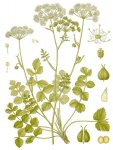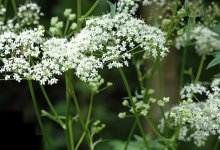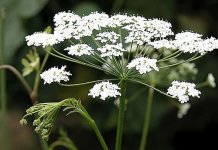Heather-thistle - pimpinella saxifraga l.
Botanical characteristics. Perennial herbaceous plant 20-50 cm high. It grows in pine and small-leaved forests on the fringes, in thickets of bushes, on deposits, along roads, on meadows.
Root stem. The stem is hollow, furrowed, bare, only in the lower part is leafy. Leaves cauline, slightly developed, sitting on the vagina with narrow terminal lobes; Leaves of basal leaves ovate-oblong, along the edges dentate. The flowers are white, sometimes pinkish, collected in 5-12-ray umbrellas. Blossoms in May - June, fructifies in July - August. The fruits are small, almost black.
Used parts of the plant. Medicinal raw materials are roots, stems, leaves, flowers and seeds. Roots are harvested in spring (March-April) and in autumn (September-October); The aerial part - during the flowering of the plant, the seeds - as it ripens.
Chemical composition. All parts of the plant contain essential oil.
The roots contain terpenoids: bizabolol, saksazulen; Polyacetylene compounds, aromatic compounds: propyl-benzene, phenols and their derivatives: isoevgenol, pseudo-eugenol, their tiglals and isomers; Coumarins: pimpinellin, isopimpinelin, izobergapten, sphondine, umbelliferone, bergapten, pulezedanin, xanthotoxin, empressin.
The aerial part (stems, inflorescences, leaves) contains: carbohydrates, vitamins, flavonoids: kaempferol, glycosides of quercetin and isoramnetin.
Seeds contain fatty oil (up to 29%), in which the acids: petrozelin, palmitic, stearic, oleic, linoleic, linolenic; Phenolic compounds, coumarins.
Application. Roots were included in the domestic pharmacopoeia of the 3rd and 4th editions, are included in the Swiss and German pharmacopoeias as an expectorant for respiratory diseases and chronic laryngitis.
In homeopathy, the juice of fresh flowering plants is used for headache and as a haemostatic agent.
In folk medicine of many countries the thigh-thresher is used as infusions and decoctions for pneumonia, bronchitis, trachitis, gastritis, kidney stone disease, ascites, gout, enuresis, as a diuretic, diaphoretic, analgesic antiseptic lactogenic. In Bulgaria, flowers and seeds are applied orally and externally with vitiligo; Externally in the form of rinses - with angina. Fresh juice discolored pigment spots.
In the experiment, femoral preparations have antihypertensive and vasodilating properties, are active in sarcoma.
Young leaves are used for salads.
Recently, interest in the plant has been growing due to the fact that in the foreign literature data on its antitumor activity are presented.
Preparation
- For broth, take 10-15 g aboveground part of the plant or roots, chop, pour 200 ml of boiling water, insist on a boiling water bath for 30 minutes, cool 10 minutes, filter. Take 1/3 cup 2-3 times daily before meals.
- For infusion take 20 g of leaves or flowers or mixtures of them, pour 200 ml of boiling water, insist on a water bath for 15 minutes, cool 45 minutes, filter. Take 1/3 cup 3 times daily before meals.
- Tincture from the roots is prepared on 70% alcohol at a rate of 1: 5, insists in a dark place for 12-15 days. Take 30-40 drops per reception, you can gradually increase to 1 tsp 2-3 times a day before meals.





Comments
When commenting on, remember that the content and tone of your message can hurt the feelings of real people, show respect and tolerance to your interlocutors even if you do not share their opinion, your behavior in the conditions of freedom of expression and anonymity provided by the Internet, changes Not only virtual, but also the real world. All comments are hidden from the index, spam is controlled.